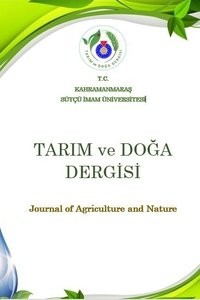Tavuk Etlerinden İzole Edilen Escherichia coli O157:H7’nin Antibiyotik Dirençi
Bu çalışmanın amacı, tavuk etlerinde E. coli 0157:H7 varlığı ve antibiyotik dirençini araştırmaktır. Köy (n=50) ve çiftliklerden (n=50) toplanan 100 tavuk hijyenik koşullarda kesildikten sonra, göğüs kısmından alınan et örnekleri geleneksel, biyokimyasal ve mikroskobik yöntemlerle analiz edilmiştir. Ayrıca elde edilen E. coli 0157:H7 isolatlarının 12 farklı antibiyotiğe karşı direnç özellikleri test edilmiştir. Geleneksel yöntemlerle yapılan analizlerde 4 örnekte muhtemel E. coli 0157:H7 kolonileri görülmüştür. Doğrulama testleri RapIDTM ONE sistemi ile yürütülmüş ve 4 örneğin E. coli O157:H7 ile kontamine olduğu belirlenmiştir. Bu örneklerin orijinleri incelendiğinde, kontamine olan örnekler köylerden toplanmıştır. Köy tavuklarındaki E. coli O157:H7 varlığı çiftlerinkinden yüksek olmuştur. Bunun muhtemel nedeni, kasabalarında aşı gibi yeterince koruyucu önlemlerin alınmamasından kaynaklanmaktadır. Et örneklerinden izole edilen E. coli O157:H7’ların Amoksillin, Ampisillin, Kloroamfenikol, Kiprofloksin, Doksisiklin, Streptomisin ve Tetrasiklin antibiyotiklerine karşı direnç gösterdiği bulunmuştur.
Anahtar Kelimeler:
RapIDTM ONE test, antibiyotik dirençlilik, E. coli O157:H7 suşu, patojen izolasyonu, tavuk eti
Antibiotic Resistance of Escherichia coli O157:H7 Isolated from Chicken Meats
The aim of the study was to estimate the prevalence and antibiotic resistance of E. coli 0157:H7 isolated from chicken meats. One hundred chickens from villages (n=50) and farms (n=50) were slaughtered under hygienic conditions. Meat samples were taken from chest area and analysed by conventional, biochemical and microscopic methods. In addition, the antibiotic resistance of the isolates was tested against 12 different antibiotics. Analyses revealed that, probably, four samples contained E. coli O157:H7. Confirmation tests were performed with the RapIDTM ONE system and the results showed that only four samples contaminated with E. coli O157:H7. When the samples origins were examined, the samples that contaminated with E. coli O157:H7 were found to be from the villages. The prevalence of E. coli O157:H7 was higher in villages than in farms. The probable reason for the high number of E. coli O157:H7 in the villages is related to lack of vaccination and hygiene. The antibiotic sensitivity test of E. coli O157:H7 showed that isolates were resistance to Amoxicillin, Ampicillin, Chloramphenicol, Ciprofloxacin Doxycycline, Streptomycin and Tetracycline antibiotics.
Keywords:
antibiotic resistance, E. coli O157:H7 strain, pathogen isolation, RapIDTM ONE test, chicken meat,
___
- Abdul-Raouf UM, Ammar MS, Beuchat LR 1996. Isolation of Escherichia Coli O157:H7 From Some Egyptian Foods. Int. J. Food Mic., 29:423-426.
- Başlangıç: 1997
- Yayıncı: Kahramanmaraş Sütçü İmam Üniv.
Sayıdaki Diğer Makaleler
Orta Doğu Fırat Havzası'nda Su Eksikliğinin Susamın Biyokimyasal ve Büyümesine Olan Etkisi
Türkiye’den Yeni Teratolojik Kene (Acari: Ixodidae) Örnekleri
Tavuk Etlerinden İzole Edilen Escherichia coli O157:H7’nin Antibiyotik Dirençi
Ahmet İNANÇ, Ari Suleiman MUSTAFA
Mehmet Sait EKİNCİ, İsmail AKYOL, Ahmed Karem RAMADAN, Ferit Can YAZDIÇ, Emin ÖZKÖSE
